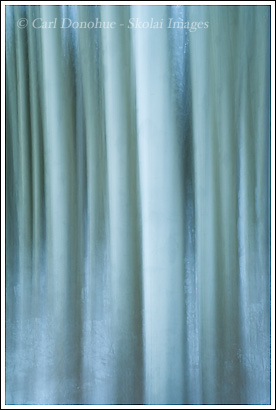Quaking aspen, Populus tremuloides, Wrangell-St. Elias National Park and Preserve, Alaska.
Hey Folks,
I was looking through some older images tonight, and found this one from last fall. This is from a little stand of Quaking aspen (Populus tremuloides) that I’ve photographed a few times. I’d actually been looking for some wildlife to photograph, but was thwarted yet again in my quest, so, as the light faded, I headed for this stand of aspen. I had photographed them a number of times, but never really played with the camera panning technique here before. This was a situation where digital photography was a real help; I could take an image, review the frame on the LCD on the back of the camera, and see what I liked, or disliked, and figure out what I needed to do in order to create the kind of image I was looking for.
Now, generally I don’t post the ‘photo techs’ on images, because I think to do is largely useless information. But for this kind of image, where the techs clearly play such a large role, it might be helpful to some readers. The exposure was 15 seconds, at f11. I turned the camera’s ISO down as low as I could (ISO=100 on my D2x) in order to allow me to open up the exposure. The longer I opened it, the more I enjoyed the results. I believe I used a polariser, but can’t recall for certain. If so, it was merely to reduce the light and even further decrease the shutter speed. Depth of Field, though adequate at f11, wasn’t really critical as the image is so blurred anyway.
I had the camera mounted on my tripod, as I do for virtually everything I shoot, and used a ballhead. I don’t have the L plates for my cameras, and so have to flop the head over to the side to shoot verticals; this is one example of where that’s advantageous, in my opinion because it allows me to keep the camera pointed through the little slot on the side of the head, and then when I pan it up and down, slowly, it remains more closely aligned with the original composition. So I let the camera remain still for a part of the exposure, then slowly panned it up and down, to blur the image a little.
Other than a few small adjustments in photoshop afterward, to increase saturation and contrast slightly, I did very little post-processing. What’s really interesting to me is how much more I enjoy these images now than I did when I first reviewed them. I might post another tomorrow. I don’t shoot many of these kinds of frames, so it’s a challenge to make something “work” when I do make the effort. So anyway, that’s the “tech stuff”.
I also really enjoy the process of creating the image, standing in the cold late October evening, alone in the forest, playing with imagery. One of the key things I stress when I teach my guitar students is that the operative word we use when we talk about playing music is ‘play’. We don’t work, we play. Play is a part of life we don’t do enough of, particularly in this culture, particularly as adults, and particularly as men; and I think we suffer for it.
The creative process can be a great outlet for play. So my photography is often a very playful process, I suppose – more so than most. I can get giddy trying to make a photo. Sometimes I’m more serious about it (like when my camera doesn’t work), but I find I can really enjoy the playfulness of trying new compositions, of looking again and again at a scene, of discovery, rediscovery, of the exploration of a scene or subject. It’s a fascinating process. To then come back to the images over a year later and rediscover them can be similarly fun. I’m having good time with it.
Cheers
Carl

Now you’ve done it, Carl. The editorial gestapo does not look favorably on playfulness in photography. Label it “art”… quickly!
Guy
Carl you know I love this style of image and have done plenty myself. I like the cool tones in this image. It’s lie the trees turned bare are facing winter themselves.
Interesting that the first thing that came to my mind when seeing this was icicles, not trees. I tend to like the way the details “flutter” away in the bottom of the image – giving more significance to it being a passing moment, if not in time, but perhaps our imaginations.
Hey folks,
Guy – Au contraire, amigo. They love playfulness. They just don’t like deceipt. 🙂
Dan – I tried warming it up a little, and didn’t enjoy the results as much as I do the cooler tones, like you mentioned. Glad to hear I’m not the only one.
Mark – that’s a great description, thanks. That imagination process is part of the play I enjoy. Being open to allow that playfulness is important, I think.
Cheers
Carl
That is cool Carl!
Hey Ron,
Thanks man.
Cheers
Carl